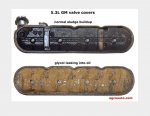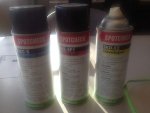I don't pressure test past radiator cap pressure rating, but each their own with no bad feelings. Maybe OK to do with the radiator out of the circuit, but the top tank of the M35 radiator has a lot of surface area, even 7psi is a lot in my personal opinion. The system will never get above cap pressure, so testing higher is putting the system under a situation it should never really be able to do on its own. I just built a hovercraft for my daughters science class this past weekend with a 120v leaf blower, and it can lift 2 adults easily, with just leaf blower pressure, which is less than 1 psi, but it is applied to 1800 square inches across a 4' diameter plywood disk. I'm not putting more than 7psi on your radiator. But the truck is cold when you are running it, meaning the coolant pressure is near zero with your constant spinning fan, if 7psi doesn't push coolant into the oil, how can 0psi? It is hard for you to see bubbles in the radiator with the curved cap neck, but your head gaskets looked perfect as expected when we pulled the heads. I think something is cracked. If so, now it would just be a matter of finding it, and what to go through to do that? I thought we heard a snap when we were torquing the heads down. I'll drop the Magnaflux kit off at your work or house today on lunch. Read the directions and just follow them. It is simple to use, all aerosol. Best to try it on something cracked first so you know how to use it and know what you are looking for. If nothing surface level shows up, I'd stop throwing time and money after it. You may have to cut your losses on the parts you purchased. Pull the engine from your good running 109, install it, close the hood, and be done with it and onto the next thing. I'll buy the 109 roller and put my DD 6-71T into it with a radiator behind the cab. Scrap the box, and put an old school wrecker boom or rollback bed on the back.You should have done more through diagnostics before pulling it apart. Detailed compression and leak down data for each cylinder, cold and warm. On leaky cylinders, try to trace where the air is escaping to. Could also apply 20psi to long block with radiator removed. You could have an oil cooler leak. I just fixed my washing machine timer, and the float switch air pressure tube plugged with muck 2 days later and overflowed, to be torn back apart again. It happens. Almost anything that can happen, will happen, eventually.







